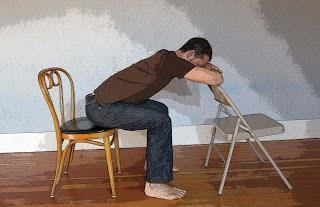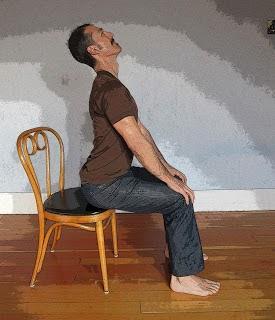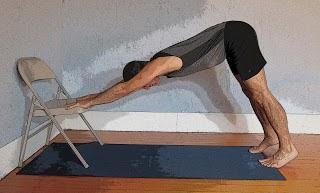Q: I teach a chair yoga class which cannot go to the floor for healthy aging. How can I do a safe inversion or back stretch that does not stress the osteopenic back?
A: If you teach chair yoga, many students are older or infirm and not able to transfer from standing or sitting in a chair to the floor, where you might have them do any number of reclining poses that could stretch the back or approach an inversion, like Legs Up the Wall pose (Viparita Karani).
If by “back stretch” you mean a forward bending action of the spine, like in Standing Forward Bend (Uttanasana), in light of possible osteopenic or osteoporotic spine, you need to be careful with most forward folding positions (see What is Ostepenia and How Can Yoga Help?). It is not hard to do a seated version, however, if that is what you are looking for. One of my favorites that is fairly shallow and would not create too much force on the vertebrae of the spine would involve placing a second chair in front of the first, facing it away from you. Then ask your students to tip as much as possible from the hips and place their crossed forearms on the top seat back of the chair in front of them. This is similar to seated forward fold we showed for our Office Yoga series (see Featured Pose: Chair Forward Bend).
 If, however, by “back stretch” you are referring to a back-bending action, then there is a bit less concern of hurting the spines of students with OP. In seated Cat/Cow pose, the Cow variation is a nice, easy backbend shape that most could do in the chair. (See Featured Pose: Chair Cat Pose.)
If, however, by “back stretch” you are referring to a back-bending action, then there is a bit less concern of hurting the spines of students with OP. In seated Cat/Cow pose, the Cow variation is a nice, easy backbend shape that most could do in the chair. (See Featured Pose: Chair Cat Pose.)  Or, have the students stand behind the chair, use the top back rung for their hands for balance purposes and do a gentle standing backbend from Mountain pose (Tadasana).
Or, have the students stand behind the chair, use the top back rung for their hands for balance purposes and do a gentle standing backbend from Mountain pose (Tadasana).As for inversions, this may be a bit tougher. You could have them put their chairs against the wall, and if they still have good hip mobility of rolling the pelvis over the femur bones, you could do a Downward-Facing Dog version with the hands on the seat of the chair, walking the hips and feet back into this higher version of regular Downward-Facing Dog, but with a slight downward slant from hips to hands. Make sure they bend their knees as they walk forward towards the chair at the end of the pose, and rise up slowly monitoring for any lightheadedness or dizziness. (See Featured Pose: Downward-Facing Dog (Chair Version)).
 And you could show the class how to do Legs Up the Wall pose on the ground, demonstrating it for them, and suggesting they try this at home in their beds, swinging the legs up the headboard side of the bed if the bed is up against a wall. I’d have them only stay for 2 minutes or so at first, as you will not be there to monitor them. Of course give them all the usual precautions regarding inversions and high blood pressure and glaucoma, as the older your crowd, these conditions are more common. I hope these suggestions give you things to consider. And armed with the information from our posts on OP, you can be creative in your approach to working with your chair yoga classes.
And you could show the class how to do Legs Up the Wall pose on the ground, demonstrating it for them, and suggesting they try this at home in their beds, swinging the legs up the headboard side of the bed if the bed is up against a wall. I’d have them only stay for 2 minutes or so at first, as you will not be there to monitor them. Of course give them all the usual precautions regarding inversions and high blood pressure and glaucoma, as the older your crowd, these conditions are more common. I hope these suggestions give you things to consider. And armed with the information from our posts on OP, you can be creative in your approach to working with your chair yoga classes. —Baxter

